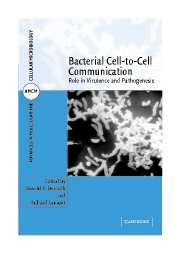Book contents
- Frontmatter
- Contents
- List of Contributors
- Preface
- 1 Quorum sensing and regulation of Pseudomonas aeruginosa infections
- 2 The Pseudomonas aeruginosa quinolone signal
- 3 Quorum-sensing-mediated regulation of plant–bacteria interactions and Agrobacterium tumefaciens virulence
- 4 Jamming bacterial communications: new strategies to combat bacterial infections and the development of biofilms
- 5 Quorum-sensing-mediated regulation of biofilm growth and virulence of Vibrio cholerae
- 6 LuxS in cellular metabolism and cell-to-cell signaling
- 7 LuxS-dependent regulation of Escherichia coli virulence
- 8 Quorum sensing and cell-to-cell communication in the dental biofilm
- 9 Quorum-sensing-dependent regulation of staphylococcal virulence and biofilm development
- 10 Cell-density-dependent regulation of streptococcal competence
- 11 Signaling by a cell-surface-associated signal during fruiting-body morphogenesis in Myxococcus xanthus
- Index
- Plate Section
- References
2 - The Pseudomonas aeruginosa quinolone signal
Published online by Cambridge University Press: 08 August 2009
- Frontmatter
- Contents
- List of Contributors
- Preface
- 1 Quorum sensing and regulation of Pseudomonas aeruginosa infections
- 2 The Pseudomonas aeruginosa quinolone signal
- 3 Quorum-sensing-mediated regulation of plant–bacteria interactions and Agrobacterium tumefaciens virulence
- 4 Jamming bacterial communications: new strategies to combat bacterial infections and the development of biofilms
- 5 Quorum-sensing-mediated regulation of biofilm growth and virulence of Vibrio cholerae
- 6 LuxS in cellular metabolism and cell-to-cell signaling
- 7 LuxS-dependent regulation of Escherichia coli virulence
- 8 Quorum sensing and cell-to-cell communication in the dental biofilm
- 9 Quorum-sensing-dependent regulation of staphylococcal virulence and biofilm development
- 10 Cell-density-dependent regulation of streptococcal competence
- 11 Signaling by a cell-surface-associated signal during fruiting-body morphogenesis in Myxococcus xanthus
- Index
- Plate Section
- References
Summary
INTRODUCTION
Pseudomonas aeruginosa is a ubiquitous Gram-negative bacterium that is a major source of acute infections for immunocompromised individuals. This opportunistic pathogen also infects the lungs of most cystic fibrosis (CF) patients, causing a chronic infection that produces progressive lung damage throughout the life of the patient. P. aeruginosa's ability to survive in almost any surroundings is augmented by an intricate cell-to-cell signaling scheme that controls a large number of cell functions. Through our ongoing attempts to eavesdrop on P. aeruginosa, we have learned that communities of this organism appear to be constantly chattering among themselves as they adapt to their environment. The las and rhl quorum sensing systems of P. aeruginosa are acyl-homoserine lactone-based signal systems that have been well characterized and are nicely reviewed in Chapter 1 of this book. The focus of this chapter will be a different type of signal, which has only recently been identified. The signal is 2-heptyl-3-hydroxy-4-quinolone and is referred to as the Pseudomonas quinolone signal (PQS). This signal is unique in that it is the only known quinolone molecule used as a cell-to-cell signal and P. aeruginosa is the only organism known to produce it.
DISCOVERY OF PQS
PQS was discovered while studying the effects of the rhl quorum sensing system on lasB induction. The lasB gene encodes LasB elastase, a protease considered to be a major P. aeruginosa virulence factor (1, 33).
- Type
- Chapter
- Information
- Bacterial Cell-to-Cell CommunicationRole in Virulence and Pathogenesis, pp. 23 - 38Publisher: Cambridge University PressPrint publication year: 2006



